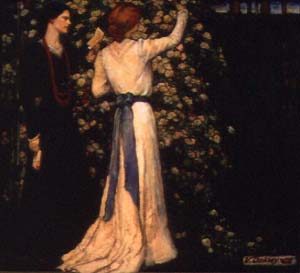I recently read The Red Rose Girls: An Uncommon Story of Art and Love a biography of three women, who styled themselves after a picturesque inn where they lived and worked together. They were extraordinarily successful during what has been termed the “golden age of illustration in America.”
Primarily remembered for their representations of children and domestic life, illustrators Jesse Willcox Smith (1863-1935), Elizabeth Shippen Green (1871-1954), and Violet Oakley (1874-1961) captivated early-twentieth-century society with their brilliant careers .
Smith, Green, and Oakley were professional artists at a time when it was more common for women to take art classes as a symbol of social accomplishment rather than as a serious endeavor. They studied at the Pennsylvania Academy of Fine Arts and met as students in illustrator Howard Pyle‘s illustration class at the Drexel Institute in Philadelphia. Pyle provided specialized training in the practical and aesthetic aspects of illustration, encouraging his female students to take their careers seriously. This was unusual for the time, as female students were prohibited from studying life drawing in most art schools and typically studied art in segregated classes. Only those who were extremely determined made their way in the male-dominated art world. Illustration, however, was considered an acceptable career for women because the creation of images for childrens books and the newly burgeoning field of magazines were deemed an extension of womens “natural” talents for decorating and child rearing.
![The Book of the Child [Frontispiece], by Elizabeth Shippen Green and Jessie Willcox Smith](http://infoshare1.princeton.edu/rbsc2/ga/unseenhands/collection/thumbnails/F2DSC_0016.jpg) Their notable achievements include Elizabeth Shippen Green’s exclusive contract with Harper’s Magazine, for which she designed hundreds of covers and interiors over a twenty-three year period. Violet Oakley’s was commissioned in 1902 to paint eighteen murals in the new Pennsylvania State Capitol in Harrisburg, the first time an American woman artist had been given such a prestigious public commission. Jesse Willcox Smith became famous for her idealized pictures of children and domestic life in Collier’s, Harper’s, Ladies Home Journal, and Scribner’s magazines, among many others. In addition she illustrated more than forty popular books.
Their notable achievements include Elizabeth Shippen Green’s exclusive contract with Harper’s Magazine, for which she designed hundreds of covers and interiors over a twenty-three year period. Violet Oakley’s was commissioned in 1902 to paint eighteen murals in the new Pennsylvania State Capitol in Harrisburg, the first time an American woman artist had been given such a prestigious public commission. Jesse Willcox Smith became famous for her idealized pictures of children and domestic life in Collier’s, Harper’s, Ladies Home Journal, and Scribner’s magazines, among many others. In addition she illustrated more than forty popular books.

Ironically, in order to be viewed as serious professional artists, these women chose to forgo the very domestic life they so romantically portrayed. Committed to remain single and childless, they made a home together and relied on the support and domestic work of their housekeeper and friend, Henrietta Cozens, to sustain their prolific careers. Cozens was not an artist, but gardened, cooked, and managed the household for the other three. Living together in their extended and unconventional family liberated these women to some extent from domestic distractions, while the supportive environment they allowed each other encouraged and sustained them in creating a world where art and life were inseparable.

In their genteel way these women were rebels, and yet their story, and their stylized illustrations were the epitome of respectability.